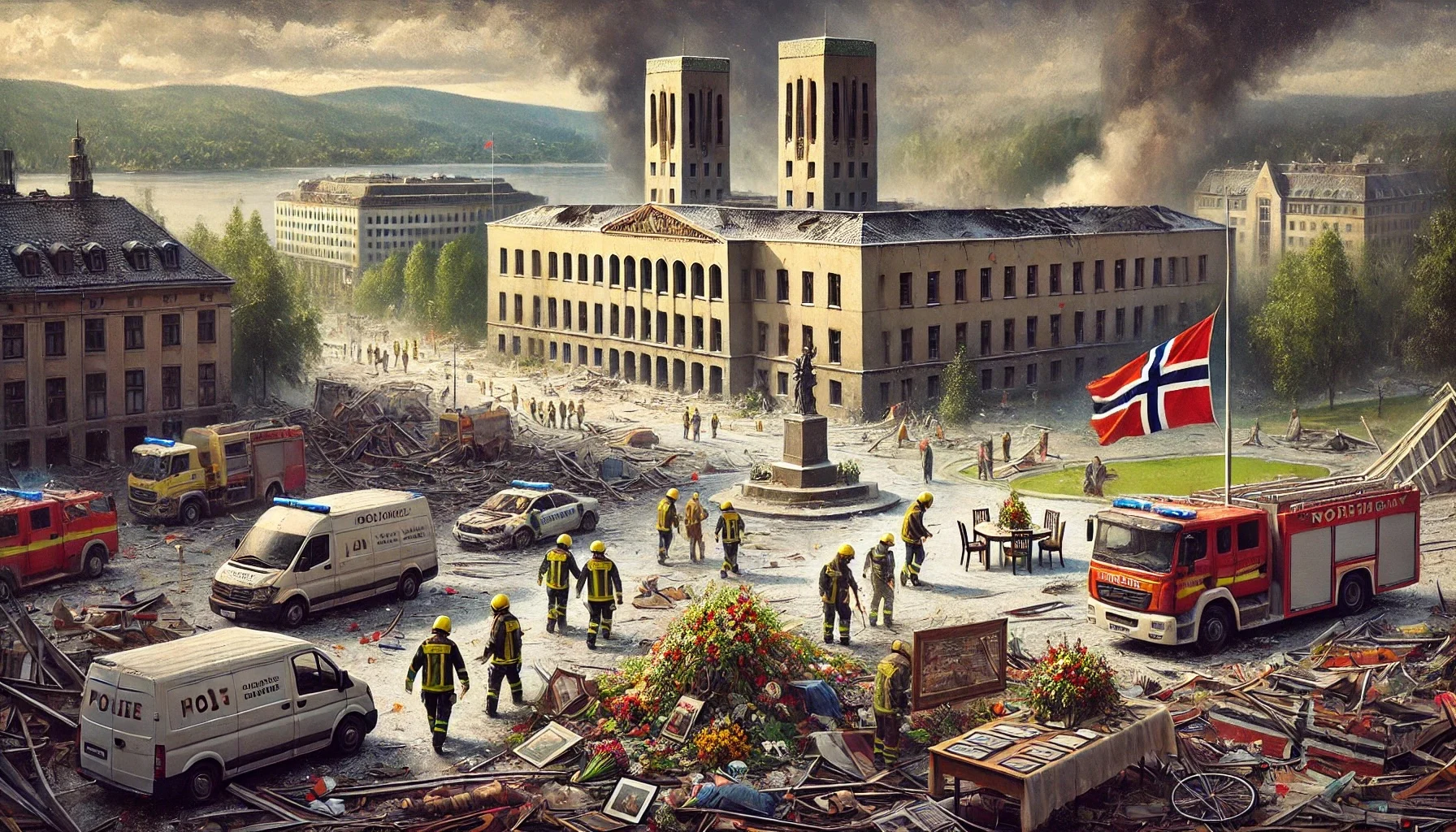
The 2011 Norway Attacks
by: The Calamity Calendar Team
July 22, 2011
A Quiet Afternoon Shattered by Terror
On a summer afternoon in Oslo, the heart of Norway’s government quarter was abruptly thrown into chaos. At 2:09 PM on July 22, 2011, Anders Behring Breivik detonated a powerful car bomb, targeting the offices of the Prime Minister and surrounding buildings. The explosion was devastating, killing eight people and injuring many more, as the blast shattered windows, collapsed structures, and sent plumes of smoke billowing into the sky.
The Immediate Aftermath in Oslo
As emergency responders rushed to the scene, Oslo descended into panic. Streets were quickly cordoned off, and the injured were hurried to hospitals. Amid the confusion, authorities began to piece together the extent of the damage and search for clues about the perpetrator. The city, renowned for its tranquility, was now a scene of horror and destruction, with citizens and officials alike grappling with the shock of the unexpected attack.
A Sinister Plan Unfolds
While Oslo was reeling from the bombing, Breivik had already set his next, even more heinous, plan into motion. Disguised as a police officer, he traveled to Utøya Island, where the Labour Party’s youth camp was in full swing. The camp, a nurturing ground for young political enthusiasts, hosted around 600 participants that year. At 5:17 PM, Breivik arrived on the island, his police uniform providing a deceptive air of authority that belied his lethal intentions.
Thanks for subscribing!
The Utøya Massacre
At 5:22 PM, Breivik began his ruthless shooting spree. Armed and unrelenting, he moved through the island, targeting the unsuspecting youth. Panic spread as the campers realized the true nature of the threat. The serene island, typically a place of learning and camaraderie, was transformed into a terrifying battleground. The first emergency calls from Utøya came in at 5:27 PM, alerting authorities to the massacre in progress.
Despite the desperate pleas for help, communication issues and the logistical challenge of reaching the island delayed the police response. It wasn’t until 6:25 PM that Breivik was apprehended, surrendering without resistance. By then, he had claimed 69 lives on the island, adding to the eight killed earlier in Oslo, bringing the total death toll to 77.
The Nation Mourns
The scale of the tragedy sent shockwaves throughout Norway and the world. Vigils and memorials were held nationwide, as a grieving nation sought to come to terms with the brutality of the attacks. The psychological scars were deep, not only for the survivors and the families of the victims but for the entire country. The sense of security and peace that Norway was known for had been irrevocably altered.
Analyzing the Aftermath
In the wake of the attacks, Norway underwent a period of intense reflection and evaluation. The immediate response to the bombing and the shooting revealed significant gaps in emergency preparedness and coordination. A commission was established to investigate these failures, leading to widespread changes in how the country handled security threats. Improvements were made in emergency response protocols, communication systems, and inter-agency cooperation.
Legal and Policy Reforms
Breivik’s trial was a pivotal moment in Norway’s judicial history. Found guilty of mass murder, causing a fatal explosion, and terrorism, he was sentenced to 21 years of preventive detention, a term that can be extended indefinitely as long as he is deemed a threat to society. The trial, which garnered international attention, was not just about seeking justice but also understanding the motivations behind such extremist acts.
Ongoing Impact and Memory
The 2011 attacks remain a crucial point of reference in discussions about extremism, radicalization, and national security in Norway. The survivors and the families of those lost have played an essential role in keeping the memory of the event alive. They continue to advocate for measures to prevent such tragedies in the future, emphasizing the importance of tolerance, understanding, and vigilance against extremist ideologies.
Conclusion
The 2011 Norway attacks were a stark reminder of the devastating impact of extremism and the need for robust security measures. The coordinated efforts of Breivik highlighted significant vulnerabilities, prompting Norway to overhaul its approach to counter-terrorism and emergency response. As the nation continues to heal, the memory of those lost on that tragic day serves as a powerful testament to resilience and the enduring fight against hatred and violence.
Stay in the Loop!
Become a Calamity Insider and get exclusive Calamity Calendar updates delivered straight to your inbox.
Thanks! You're now subscribed.